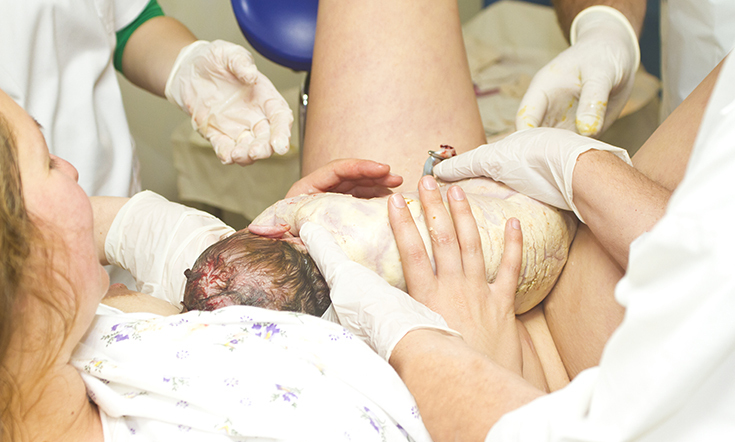

The third stage of labour is the delivery of your Placenta (afterbirth) and the membranes that your baby has been protected by for the past nine months. Inside the uterus, the placenta plays the role of lungs, liver, and the kidneys for the babies. Blood flow to these organs is minimal until the baby takes a first breath, at which time big changes begin to the body of your baby. However, there are a lot of important things for you to know on what to expect during labour.
What Is The Third Stage Of Labour?
This stage begins from the birth of the baby and ends with the delivery of the placenta. The average length for all vaginal deliveries ranges from five to fifteen minutes. It is the most intense, and exhausting phase, mentally and physically. It is also called the active or transitional phase, where the contractions come 2 or 3 minutes apart and last between 60 to 90 seconds.
What Happens In The Third Stage Of Labour?
During the last stage of labour, the placenta, which has acted as your baby’s life support system during the entire pregnancy, will be delivered. It could take about 5 minutes to half and an hour, in which time you will be expected to help expel the placenta by pushing.
The health care provider immediately recognises that from a practical perspective, the risk of complications continues for some period after delivery of the placenta. For this reason, many authorities have suggested a so-called fourth stage of labour, which begins with the delivery of the placenta and lasts for few hours after birth. Once it is delivered, your doctor might need to take care of any tears or lacerations that have happened during delivery or stitch up an episiotomy.
How To Manage The Third Stage Of Labour?
Managing the third stage of labour has two benefits for the mother. First, with medical management, you are less likely to lose a significant amount of blood (which means upwards of 500ml/approximately 1 pint). Secondly, it is faster; an average of eight minutes against an average of 15 minutes for a natural third stage ? although at this point you will probably be focusing on your new baby and unaware of the time.
Oxytocin Administration
Oxytocin (10 units IV or IM) is preferred over other uterotonic drugs because it is effective 2-3 minutes after injection, has minimal side effects and can be used in all women. The advantage of this method is that it is fast, usually in five to ten minutes, and in most cases within 15 to 20 minutes. There is little blood loss and a lower risk of heavy bleeding.
The disadvantage is that one of the drugs used, such saergometrine, may make you feel sick, or give you a headache. However, many maternity units now use a single drug, oxytocin, which is less likely to cause these side effects than syntometrine (a mixture of oxytocin and ergometrine).
Clamping the cord
It is important to delay this procedure until after the oxytocin has been administered. The medical management of the third stage the cord is normally clamped immediately after the birth of the baby, usually within 30 seconds, and before it stops pulsating. The earlier the cord is clamped the less blood will pass from the placenta to the baby by placental transfusion.
Controlled cord traction
The health care provider will wait for a few minutes for signs that your placenta has separated. She will then gently draw on the cord to extract the placenta, while maintaining counter pressure on your uterus with her other hand.
What Are The Signs And Symptoms Of The 3rd Stage Of Labour?
You will feel a strong pressure in the perineum or lower back and your legs will cramp. You may also experience mild contractions of about 60 seconds as the uterus squeezes out the placenta from the uterine wall and moves it down so that you can push it out. Nausea, vomiting and chills or cold sweat is also likely.
Signs Of Placental Separation
- The uterus becomes globular in shape and firmer – This occurs as the placenta goes down into the lower segment of the uterus and the body of the uterus continues to retract.
- The uterus rises in the abdomen – The descent of the placenta into the lower segment, and finally into the vagina, moves the uterus upward.
- The umbilical cord descends three inches or more further out of the vagina. This is the most reliable sign in which the placenta separates and is pushed into the lower uterine segment by progressive uterine retraction.If the clamp is placed in the cord near the perineum makes it easier to appreciate this sign. But don’t apply traction on the cord without counter-traction on the uterus above the pubic area; otherwise, one may mistake cord lengthening due to impending prolapse or inversion for that of uncomplicated placental separation.
- Sudden gush of blood – The retro-placental clot is able to escape as the placenta descends to the lower uterine segment and it usually forms in the center. It also escapes following complete separation however, if the blood can find a path to escape, it may do so before complete separation and thus is not a reliable indicator of complete separation.
In addition, sometimes it is associated with hemorrhage and a prolonged 3rd stage labour, with the delivery of the leading edge of the placenta and maternal surface first (Matthews Duncan method), rather than the cord insertion and fetal surface, which is more common (Schultze method).






















